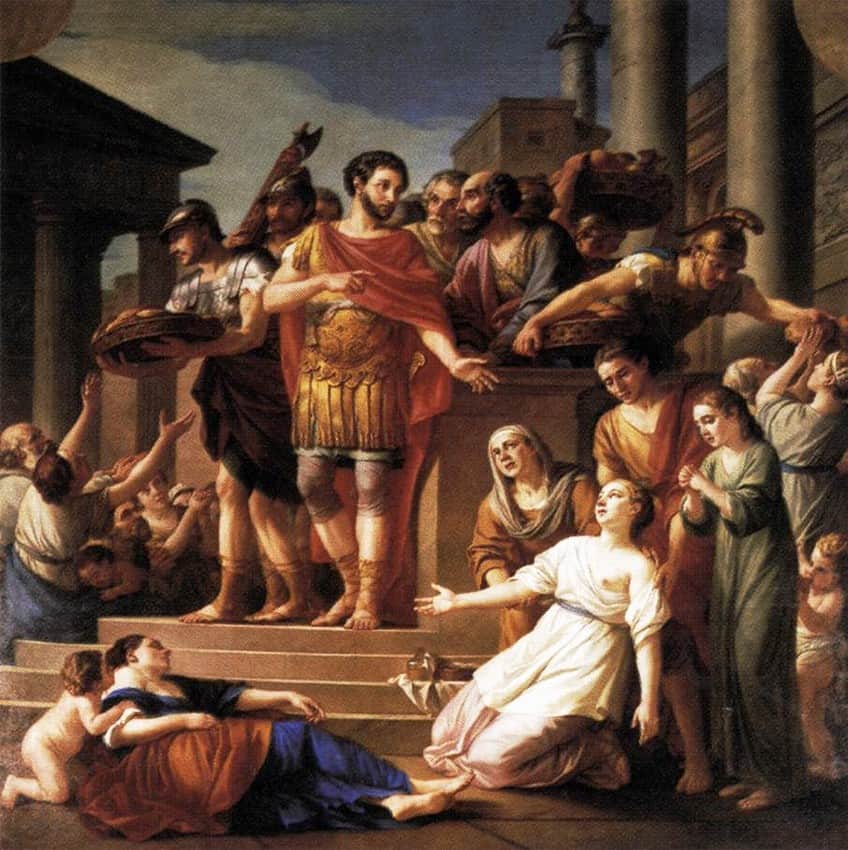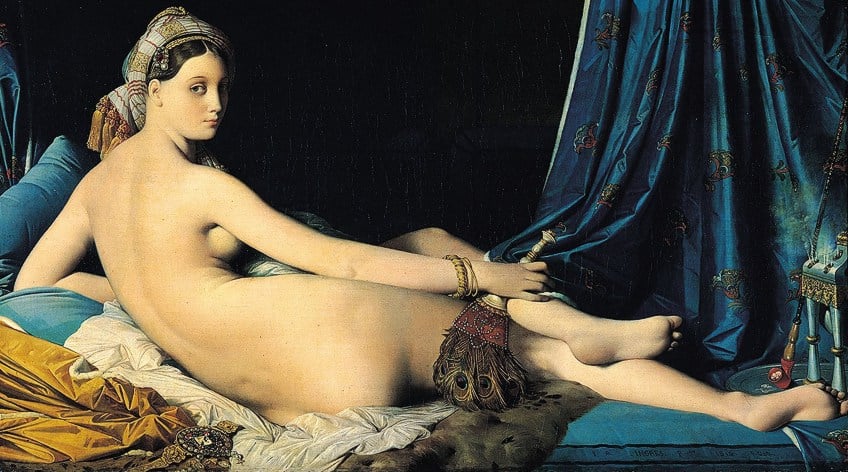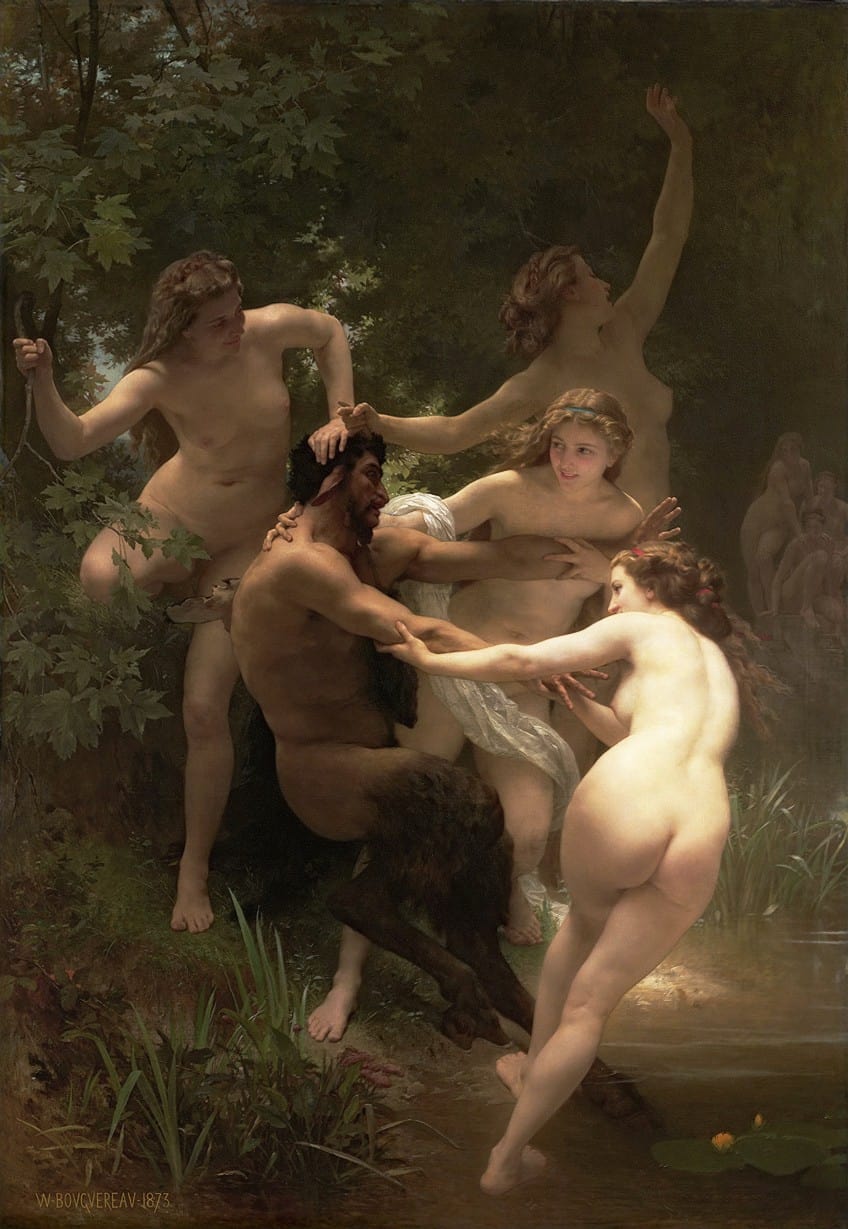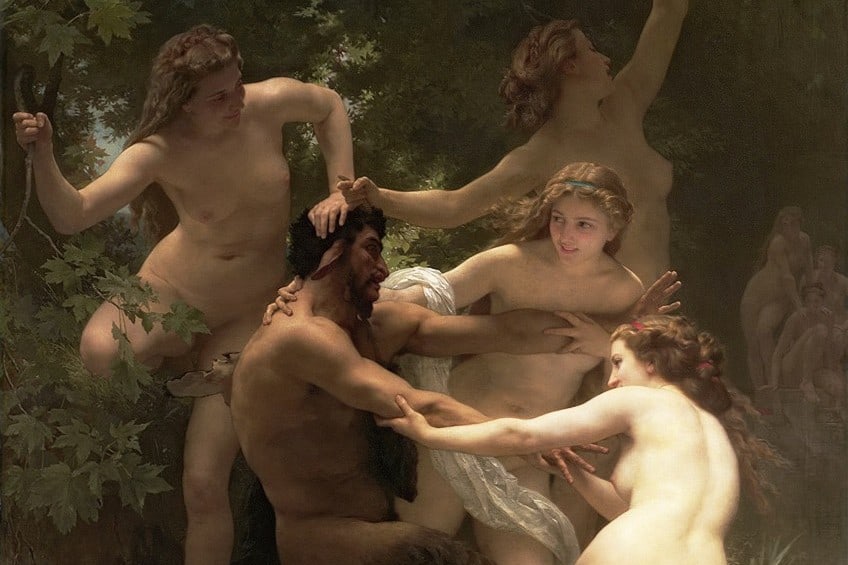Famous Neoclassical Paintings – The Best Neoclassical-Period Art
Neoclassical-style art was heavily influenced by Greco-Roman artworks. Neoclassicism paintings focus on two elements: proportion and balance of composition. Neoclassical-period art strove for perfection without any emotional involvement. In this article, we will discuss the significance of Neoclassical artwork and explore some of the most famous Neoclassical paintings.
What Is Neoclassical-Style Art?
As with earlier Greco-Roman art, Neoclassical painters portrayed themes from Classical history and literature. They employed dark colors with intermittent vivid accents to communicate ethical messages of self-sacrifice that were consistent with Antiquity’s claimed ethical perfection.
The resurgence of Classical Antiquity’s aesthetic principles did not happen immediately.
It was influenced by Renaissance artworks as well as the more austere forms of Baroque, the spirit of Enlightenment, discontentment with the Rococo, and a new appreciation for Nicolas Poussin’s classical history painting style. Additionally, objectively speaking, there is no obvious distinction between Neoclassicism and Romanticism. This is because a renewed interest in Classical Antiquity can rapidly turn into a sentimental yearning for the past.
Famous Neoclassical Paintings
In portrayals of classical events, people, and concepts, as well as historically accurate locations and clothes, Neoclassical artwork stressed austere linear design. Neoclassicism paintings are distinguished by the use of a smooth paint surface that conceals brushwork, straight lines, the representation of light, the use of little color, and the precise, sharp articulation of shapes. Neoclassical paintings also featured historical events, mythical themes, and ancient Rome’s architecture and monuments. Here is our list of famous Neoclassical paintings.
Marcus Aurelius Distributing Bread (1765) by Joseph Marie Vien
| Artist | Joseph Marie Vien (1716 – 1809) |
| Date Completed | 1765 |
| Medium | Oil on canvas painting |
| Location | Musée de Picardie, Amiens, France |
This masterpiece was made by the artist when he was 49 years old. It was produced in response to Louis XV’s commission plan, which called for a cycle of works representing the qualities of the great monarchs. It was not warmly accepted by everyone. Joseph Marie Vien earned the Prix de Rome at the age of 26 in 1742. When he was in Rome, the excavations at Pompeii and Herculaneum started, which strongly affected him.
He was a forerunner of the Neoclassical style. He rose to prominence and was appointed director of the French Academy at Rome in 1776.

Jacque-Louis David was one of his numerous students. Napoleon made him a senator and count after appointing him as the king’s first artist in 1789. He passed away the following year and was interred in the Pantheon. In the artwork, we can see Marcus Aurelius accompanied by Roman soldiers who are handing out loaves of bread to the poor.
The people are frail and plead for life-giving nourishment from the soldiers as they descend the stairs.
Self Portrait (1775) by Angelica Kauffman
| Artist | Angelica Kauffman (1741 – 1807) |
| Date Completed | 1775 |
| Medium | Oil painting on canvas |
| Location | National Portrait Gallery, London, United Kingdom |
In this artwork, Kauffman is seen holding a crayon and her folio, which is unusual. This position was popular for portraits of amateurs in the 18th century, particularly in England. During that period, there was a significant divide between amateur and professional female painters; amateurs lacked artistic expertise, couldn’t sell their artwork, and their work was often weak.
Nevertheless, for unexplained reasons, Kauffman related to the amateur and often portrayed herself in the same posture throughout her career.

Because there is little information on the matter, one can only assume why the painter did this, but it appears that Kauffman was interested in popularizing her work in a variety of ways. Even after becoming renowned, Kauffman felt her paintings needed to be extensively copied as prints to maintain a close link to ordinary life. It has also been stated that by portraying herself as a lady amateur, Kauffman maintained her ladylike position while keeping harmful rumors and hostility at bay.
In actuality, she was a rich, independent, and incredibly bright lady, but she was also astute enough to recognize that her community and culture were not yet prepared for such a loud, overwhelming female force.
Design (1780) by Angelica Kauffman
| Artist | Angelica Kauffman (1741 – 1807) |
| Date Completed | 1780 |
| Medium | Oil on canvas painting |
| Location | Royal Academy, London, United Kingdom |
Because it was prohibited for a female painter to paint from a male nude, Kauffman was compelled to learn about male anatomy from a classical bust in Design. Even doing so was rare and frowned upon at the time. Kauffman’s four works as a sequence were influenced in part by and portray her friend, Joshua Reynold’s beliefs in his Discourses on Art, on which he had presented courses at the Royal Academy and later published in 1788.
Despite Kauffman’s artistic qualifications, classical background, and historical painting inventiveness, the Royal Academy did not assign this collection of four works a prominent spot.
Guests would not have recognized the value of Kauffman’s works, notably Design, because they were displayed on the building’s ceiling instead of its walls. Regrettably, the canvases on the ceiling are photographic replicas of her works, whereas the actual paintings have been re-hung in the entry to Burlington House, and are not discovered much as a result of large crowds accessing the facility this way.
The Death of Socrates (1787) by Jacques-Louis David
| Artist | Jacques-Louis David (1748 – 1825) |
| Date Completed | 1787 |
| Medium | Oil on canvas painting |
| Location | Metropolitan Museum of Art, New York City, United States |
As the title suggests, this piece represents the dying moments of the famed Greek philosopher Socrates. He was found guilty of disobedience against the Pantheon of Athens, his birthplace, and corrupting the young of that city. The accusers’ major point was that they claimed he presented new deities to the populace. This crime was deemed sufficient to condemn him to execution by poisoning.
The picture shows the moment Socrates is offered the poisoned cup. His admirers are watching with bated breath as the philosopher uses his closing minutes to give a farewell statement.

Socrates died while Plato was still a young man. Plato is represented by David as an elderly man sitting at the foot of Socrates’ bed. This is only one of the numerous liberties David used when creating this piece. Another notable distortion of the narrative is the image of Apollodorus in anguish. He is the man standing behind Plato, facing the wall.
According to Plato’s portrayal, he was dismissed by Socrates for being very upset at the time.
Death of Marat (1793) by Jacques-Louis David
| Artist | Jacques-Louis David (1748 – 1825) |
| Date Completed | 1793 |
| Medium | Oil painting on canvas |
| Location | Musées Royaux des Beaux-Arts, Brussels, Belgium |
Jacques-Louis David typified both the new Neoclassical style and the instructional aspect of academic painting. However, he is most remembered for his propaganda artwork Death of Marat (1793), which turned a violent and vicious insurgent into a social martyr. Following Robespierre’s death, David was temporarily imprisoned until being pardoned by The Directory. Nevertheless, he soon switched allegiances to Napoleon Bonaparte, finally becoming the new regime’s official artist, who lavished him with honors.
Marat, one of the planners of the September Massacres of 1792, was murdered with a knife in his bathtub by Charlotte Corday, a young Girondist.

She had gained access to Marat’s residence by offering to hand over a list of counter-revolutionaries from her hometown. Marat thanked her and vowed that the conspirators would be killed the next week, at which point Corday took out a large knife and thrust it into his chest, cutting the carotid artery.
He suffered a huge amount of blood loss, which would have killed him in a matter of minutes. She didn’t try to run and was executed by guillotine a few days later.
The Intervention of the Sabine Women (1799) by Jacques-Louis David
| Artist | Jacques-Louis David (1748 – 1825) |
| Date Completed | 1799 |
| Medium | Oil on canvas painting |
| Location | Louvre Museum, Paris, France |
In 1794, David was imprisoned as a political activist. While still in jail, he envisioned a return to historical painting and began work on this painting, a piece that would keep him busy until 1799. This artwork was based on an ancient Roman story, the Sabine rape, in which Romulus and his Romans kidnapped the women of their neighbors, the Sabines, to secure the city’s population expansion. It took three years for the Sabine troops, headed by Tatius, to launch a counterattack.
The dominant subject of this historical painting is a lady, Hersilia, who puts herself in the middle of Romulus, her spouse, and Sabine Tatius, her father.

Other women cling to the soldiers, putting themselves and their offspring in the middle of the conflict too. David juxtaposed the savagery of rape with control exerted by the women through their subjugation of the situation. In the Sabines, the idea of family strife was a metaphor for the revolutionary process, which finally resulted in reconciliation and peace.
Therefore, the artwork was also a homage to the women in David’s family as well as an acknowledgment of women’s capacity as peacemakers.
Young Woman Drawing (1801) by Marie-Denise Villers
| Artist | Marie-Denise Villers (1774 – 1821) |
| Date Completed | 1801 |
| Medium | Oil on canvas painting |
| Location | Metropolitan Museum of Art, New York City, United States |
This Neoclassical artwork displays an intriguing image of a young lady artist dressed in a white gown staring directly at the observer. Originally assigned to a male artist, a recent critical study identifies Marie-Denise Villers as the author of this portrait, and art historians contend that this artwork is a self-portrait. Curiously, Villers has incorporated shattered window glass in this painting, which is supposed to be a Louvre gallery.
Villers has offered a puzzle to be unraveled with the pair standing on a parapet.

The painting does not intend to lure the observer enticingly or depict its sitter’s sexuality, and critics consider it to be a feminist artwork in essence. Other feminist critics have started to recognize the painting’s feminine aspects. Women utilized the Louvre gallery represented in this artwork to teach and receive art training. Her hair and clothes sparkle in the light as she gazes out at us, wishing to be remembered as someone who always wanted to paint.
Marie-Denise Villers was a portraitist painter from France.
The Coronation of Napoleon (1807) by Jacques-Louis David
| Artist | Jacques-Louis David (1748 – 1825) |
| Date Completed | 1807 |
| Medium | Oil on canvas painting |
| Location | Louvre Museum, Paris, France |
This is one of the biggest oil paintings ever created, which explains why the artist needed almost two years to finish it. Napoleon personally commissioned the picture in September 1804. At the time, Jacques-Louis David was already regarded as the authorized court artist and Napoleon’s artist. In December of 1804, he began work on this colossal piece of art alongside his student Georges Rouget. He didn’t finish it until January of 1808.
David’s original concept was for Napoleon to grasp the crown over his head as if honoring himself.

To avoid misunderstanding, he modified this detail slightly and had Bonaparte hold the crown ahead of him. Napoleon’s mother is seated on the throne in the backdrop. The artist painted her, but she was not present since her sons were fighting at the time. At the moment, he was arguing with Joseph Bonaparte, his brother. He had not been invited, yet David inserted him on the far left side of the picture. Napoleon’s wife may be observed crouching in front of her husband, as was customary.
The head of the Catholic Church at that time, Pope Pius VII, is seated directly behind Napoleon. He was the one who gave the coronation blessing.
The Valpinçon Bather (1808) by Jean-Auguste-Dominique Ingres
| Artist | Jean-Auguste-Dominique Ingres (1780 – 1867) |
| Date Completed | 1808 |
| Medium | Oil painting on canvas |
| Location | Louvre Museum, Paris, France |
The female naked figure appears throughout Ingres’ span of works. He had developed his efficient technique of design from his early years, employing primary forms and lines to convey both perfect beauty and energy. He delineated figures and shapes cleanly and clearly, shaping their designs with a delicate interplay of light, in contrast to Caravaggio and his followers’ harsh chiaroscuro and dramatic tenebrism.
He focused on portraying surfaces in order to create the illusion that nothing solid lies behind them.

Ingres presents a delicate, subdued nude, portrayed from the back, and defined by a peaceful and ageless sensuality, in keeping with the aesthetic of Italian neoclassicism – borrowed partly from Greek sculpture. The painting’s fascinating ambiguity derives from the delicate interaction between the supposedly chaste figure’s apparent warmth, creating a desire in the viewer to reach out and touch her, as well as the textures and forms of the objects that surround her.
The Neoclassicists painted and sculpted many modest nudes, yet chastity does not render women unsexual or unappealing – just the opposite.
Grand Odalisque (1814) by Jean-Auguste-Dominique Ingres
| Artist | Jean-Auguste-Dominique Ingres (1780 – 1867) |
| Date Completed | 1814 |
| Medium | Oil on canvas painting |
| Location | Louvre Museum, Paris, France |
Because this is a more graphic nude than the subdued Valpinçon Bather, Ingres changes it to an orientalist scene and lengthens the figure’s torso greatly to emphasize that this is a fictional lady in a fantastical image, not a real naked woman. According to research, the person was created with spine curvature, additional vertebrae, a deformed pelvis, and one arm longer than the other.
This was done entirely for artistic impact – Ingres was by no means ignorant of anatomy. The concubine is laying in a seductive stance on a sofa, her face turned towards the viewer.

Her arm draws our attention to the opulent silk curtains, while her feet and elbows draw attention to the lush velvet pillows. The cool aquamarine of the silk drape, with its red floral pattern, emphasizes the warmth of her body tones. The picture has various Ingres-style elements. Take note of the lack of illusionary depth in the image, which draws attention to the person.
She is designed with long, flowing lines, and her skin is covered in a diffused gentle light, with no dramatic chiaroscuro.
Dante and Virgil (1850) by William-Adolphe Bouguereau
| Artist | William-Adolphe Bouguereau (1825 – 1905) |
| Date Completed | 1850 |
| Medium | Oil on canvas painting |
| Location | Musée d’Orsay, Paris, France |
Dante, trapped in the dark forest, sees a hazy form emerge from the shadows. It is the Latin poet, Virgil, whose writings Dante considered instructive in moral life and literary perfection. Virgil shows him the path to redemption and becomes his companion through the labyrinths of hell. Dante Alighieri created the horrific pictures of hell that have influenced and troubled Christian consciences since the Middle Ages.
Divine retribution for transgressions was a hazy, foggy idea before Dante; Dante gave it depth and substance.

The Divine Comedy (1308 – 1320), particularly the section devoted to hell, is full of substantial, precise depictions of what happens in the netherworld, and it has had a significant effect on popular conceptions of purgatory and hell, eliciting both wonder and horror. Thankfully, it has also influenced many great painters, who have put paint to canvas and powerfully brought Dante’s horrifying words to life, allowing us to see a terrible destiny that awaits obstinate sinners.
The selection of Virgil as the escort to purgatory was likely influenced by depictions of Aeneas descending into the underworld in Virgil’s Aeneid, as well as Dante’s long-standing affection for the Latin author.
Nymphs and Satyr (1873) by William-Adolphe Bouguereau
| Artist | William-Adolphe Bouguereau (1825 – 1905) |
| Date Completed | 1873 |
| Medium | Oil on canvas painting |
| Location | Clark Art Institute, Massachusetts, United States |
A passionate satyr surprises the nymphs in the artwork. Several of the nymphs in the image have retreated into the darkness on the right. The other nymphs are bolder. We know this because we see them in the image attempting to quell the satyr’s passion by pulling him into the chilly water of the pond. He doesn’t want to go any farther, even if one of his hooves is now wet. The artwork Nymphs and Satyr was first displayed in public in Paris in 1873.
The picture was acquired by collector John Wolfe because of the attraction that Americans had for Bouguereau’s works.

He hung the artwork in his mansion amid other significant French academic works. In 1888 the picture changed hands again when it went up for sale at auction. The image was displayed at the Hoffman House Hotel’s bar for the following 13 years. The picture changed hands again in 1901 when it was auctioned.
This time, the painting vanished from public view while it was being housed in a warehouse.
Mischief and Repose (1895) by John William Godward
| Artist | John William Godward (1861 – 1922) |
| Date Completed | 1895 |
| Medium | Oil on canvas painting |
| Location | Getty Museum, Los Angeles, United States |
In the Neoclassical style of Lawrence Alma-Tadema, Godward’s 1895 painting shows an indoor scene from Ancient Greece or Rome. It features two auburn-haired youthful women clad in long billowing robes inspired by an antique chiton, composed of a sheer grey and blue material and fastened at the waist. Godward utilized two of his usual models, Hetty and Lily Pettigrew, for the two female figures.
The first woman on the left is sprawled out on a tiger hide stretched on a marble bench, her right hand raised behind her head and her left arm sprawled outward.

A second lady is reclining on a black animal hide on the floor to the right, trying to wake the other: Mischief extends her hand, placing a long white dress brooch over Repose’s brow. A second dress pin, together with a discarded hair ribbon, lays on the floor. The floor includes huge white marble tiles on the left and little triangular shapes of a white mosaic with a black pattern border on the right.
Neither of the ladies interacts with the observer, and the frigid academic manner of the painting, along with their pale complexion, renders them as a frozen statue, as does the remainder of the marble chamber.
Echo and Narcissus (1903) by John William Waterhouse
| Artist | John William Waterhouse (1849 – 1917) |
| Date Completed | 1903 |
| Medium | Oil on canvas painting |
| Location | Walker Art Gallery, Liverpool, United Kingdom |
The goddess myth describes the tale of a “talkative nymph” whom Venus reveres for her great voice and music. When she fools Juno into thinking that her husband is in the town, Juno cursed Echo, leaving her unable to utter words of her own and only able to complete the sentences uttered by others. “Yet a chatterbox, she possessed no other speech than she has today, that she could only recite the final words of many.”
This is the reason behind the auditory impact that bears her name. Echo spotted a young man named Narcissus while out deer hunting with his friends sometime after becoming cursed.

She quickly fell in love with him and trailed him discreetly. The more she gazed at him, the more she wanted him. Even though she wanted to scream out to Narcissus, Juno’s curse stopped her from doing so. During the hunt, Narcissus somehow became lost and shouted out, “Is anybody there?” Hearing the nymph repeat his words, Narcissus felt disoriented. Narcissus, startled, replied, “Come here,” only to be told the same thing. When Narcissus noticed that no one had appeared from the glade, he decided that the owner of the voice was fleeing him and shouted out once more.
That wraps up our exploration of famous Neoclassical paintings. As we have learned, Neoclassical painters created Neoclassical-style art to re-establish the classical arts of the Greeks and Romans in the contemporaneous era. Neoclassical-period artists were tired of the unnecessary extravagance of the Rococo period and wanted to return to the elements of proportion and perfection in their artworks. The excavation of the Roman archaeological cities Herculaneum and Pompeii fueled the movement’s enthusiasm.
Frequently Asked Questions
Why Did Neoclassical Painters Create Neoclassical Artworks?
Neoclassical painters, like previous Greco-Roman artists, depicted topics from Classical history and literature. They used dark hues with bright highlights to convey self-sacrifice ideas that were compatible with Antiquity’s professed ethical perfection. The revival of Classical Antiquity’s aesthetic ideas did not occur overnight. It was influenced by Renaissance paintings as well as the more austere forms of Baroque, the spirit of Enlightenment, dissatisfaction with Rococo, and a new respect for Nicolas Poussin’s classical historical painting style. Furthermore, there is no discernible boundary between Neoclassicism and Romanticism. This is because a revitalized interest in Classical Antiquity can quickly develop into a nostalgic longing for the past.
What Are the Characteristics of Neoclassical-Period Art?
It took the shape of a concentration on stark linear design in the representation of Classical ideas and subject matter, employing archaeologically precise locations and clothes, in painting. In the arts, neoclassicism is an aesthetic approach based on the antiquity art of the Greeks and Romans, which evokes symmetry, purity, moderation, and idealism. In the framework of the legacy, Classicism refers to either ancient-era art or later art influenced by antiquity, whereas Neoclassicism always relates to contemporary art inspired by antiquity. Classicizing artists favor more precise features such as line over color, clean lines over curvature, point of focus and closed arrangements over diagonal designs, and the universal over the specific. The most well-known Neoclassical painters include Jacques-Louis David, Jean-Auguste-Dominique Ingres, and William-Adolphe Bouguereau.
Jordan Anthony is a Cape Town-based film photographer, curator, and arts writer. She holds a Bachelor of Art in Fine Arts from the University of the Witwatersrand, Johannesburg, where she explored themes like healing, identity, dreams, and intuitive creation in her Contemporary art practice. Jordan has collaborated with various local art institutions, including the KZNSA Gallery in Durban, the Turbine Art Fair, and the Wits Art Museum. Her photography focuses on abstract color manipulations, portraiture, candid shots, and urban landscapes. She’s intrigued by philosophy, memory, and esotericism, drawing inspiration from Surrealism, Fluxus, and ancient civilizations, as well as childhood influences and found objects. Jordan is working for artfilemagazine since 2022 and writes blog posts about art history and photography.
Learn more about Jordan Anthony and about us.
Cite this Article
Jordan, Anthony, “Famous Neoclassical Paintings – The Best Neoclassical-Period Art.” artfilemagazine – Your Online Art Source. October 27, 2022. URL: https://artfilemagazine.com/famous-neoclassical-paintings/
Anthony, J. (2022, 27 October). Famous Neoclassical Paintings – The Best Neoclassical-Period Art. artfilemagazine – Your Online Art Source. https://artfilemagazine.com/famous-neoclassical-paintings/
Anthony, Jordan. “Famous Neoclassical Paintings – The Best Neoclassical-Period Art.” artfilemagazine – Your Online Art Source, October 27, 2022. https://artfilemagazine.com/famous-neoclassical-paintings/.



